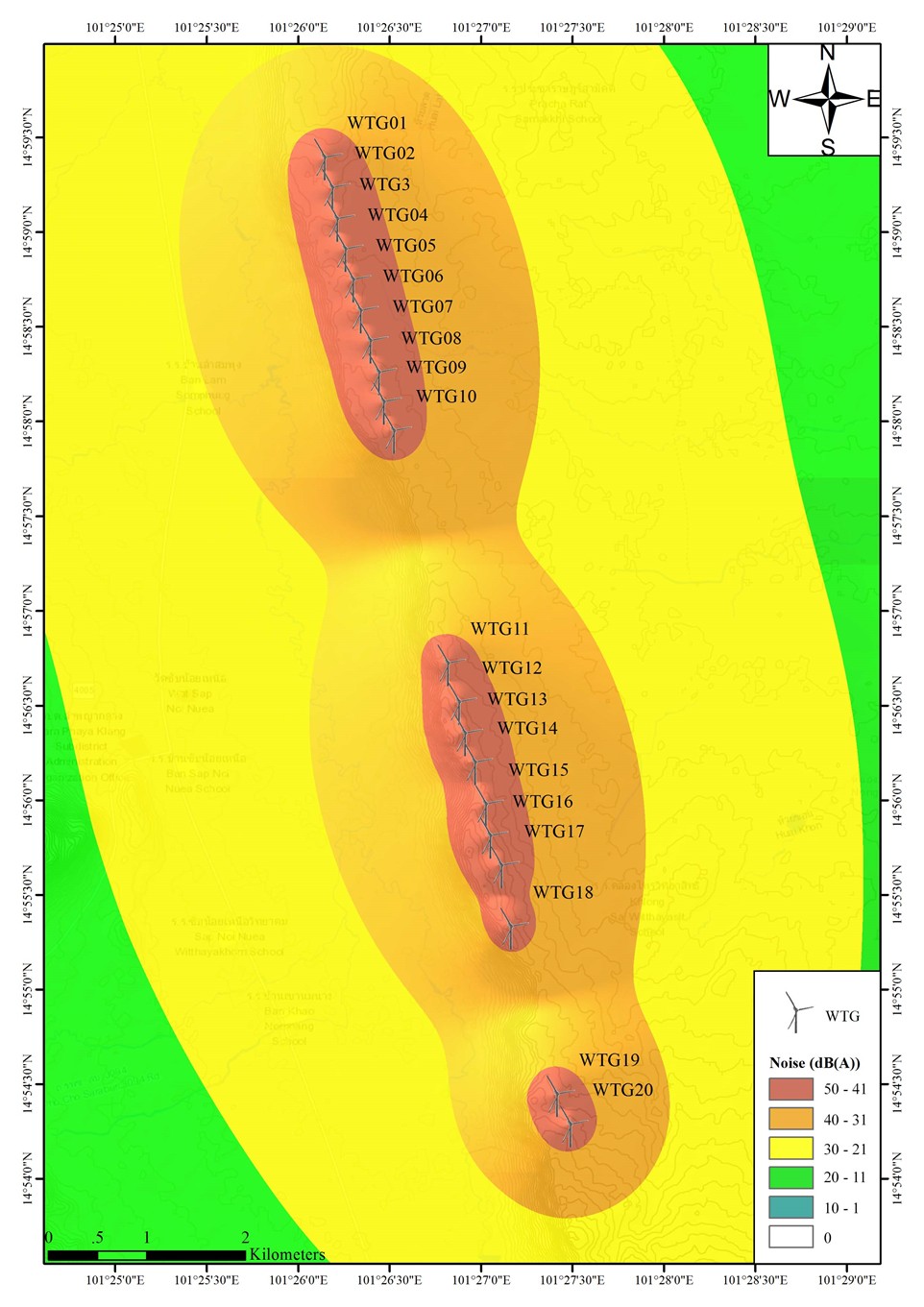Environmental Impact Assessment of Onshore Wind Power Plants: A Case Study of a 50 MW Wind Power Plant in Northeastern Thailand
Main Article Content
Abstract
This research aims to assess the environmental feasibility of a wind power plant by investigating its noise disturbances, shadow flicker, and zones of visual influence. The model is applied as a case study for a 50 MW wind power plant, located in the Nakhon Ratchasima province of northeastern Thailand. The acoustic noise emissions were analyzed using the sound propagation and absorption models under the wind conditions on the site studied. The shadow flicker around each wind turbine generator, in terms of the number of hours per year, was also simulated along with the analysis of the zones of visual influence according to the number of wind turbines that can be seen by an observer from a certain distance. The results show a maximum sound level of 47 dBA, within the allowed limits of the 50 dBA legislation of the Department of Pollution Control of the Royal Thai Government. Similarly, the shadow flicker within 1 km of the wind turbines is 10 hours/year, well below the international standard of 30 hours/year. Results of the zones of visual influence indicate that between 15 and 20 turbines are visible from observation points surrounding the potential wind power plant. The results applied to this case study suggest that the potential wind power plant is well-suited regarding its environmental impacts and should typically not incur negative impacts for the local communities. Studies like these are vital to gaining the trust of the communities living near wind power plants to address their concerns and minimize opposition.
Article Details

This work is licensed under a Creative Commons Attribution-NonCommercial-NoDerivatives 4.0 International License.
References
International Energy Agency (IEA). Electricity Market Report 2023. 2023. https://www.iea.org/reports/electricity-market-report-2023. (accessed April 25, 2023)
International Energy Agency (IEA). Renewables 2022: Analysis and Forecast to 2027. 2022. https://www.iea.org/reports/renewables-2022 (accessed May 2, 2023).
United Nations Framework Convention on Climate Change (UNFCCC). Adoption of the Paris Agreement - Paris Agreement Text English, 2015. https://unfccc.int/sites/default/files/english_paris_agreement.pdf. (accessed May 1, 2023).
Electricity Generating Authority of Thailand (EGAT). Annual Report 2021 Electricity Generating Authority of Thailand. 2022. https://www.egat.co.th/home/en/wp-content/uploads/2022/06/EGAT-Annual-2021-EN_2022-06-22.pdf. (accessed May 3, 2023).
Energy Regulatory Commission (ERC). Annual Report - Energy Regulatory Commission of Thailand. 2021. https://www.erc.or.th/en/annual-report/3749 (accessed May 3, 2023).
Energy Policy and Planning Office (EPPO). Thailand Power Development Plan (2015-2036). 2015. https://www.eppo.go.th/images/POLICY/ENG/PDP2015_Eng.pdf. (accessed April 25, 2023).
Energy Policy and Planning Office (EPPO). Meeting Resolution on Energy Saving Methods No. 2/2021 (No. 154). 2021. https://www.eppo.go.th/index.php/th/component/k2/item/17213-nepc-prayut04-08-64. (accessed April 30, 2023).
International Renewable Energy Agency (IRENA). Renewable Energy Outlook – Thailand. 2017. https://www.irena.org//media/Files/IRENA/Agency/Publication/2017/Nov/IRENA_Outlook_Thailand_2017.pdf (accessed April 10, 2023).
Global Wind Energy Council (GWEC). An Industry Perspective on Strengthening Onshore Wind Development in Thailand. 2019. https://ec.europa.eu/eurostat/statistics- (accessed April 29, 2023).
Kamdar, I.; Taweekun, J. Assessment of Wind Energy Potential of Hat Yai (Songkhla), Thailand. IOP Conference Series: Materials Science and Engineering. 2021, 1163(1), 012001. https://doi.org/10.1088/1757-899X/1163/1/012001
Waewsak, J.; Chancham, C.; Chiwamongkhonkarn, S.; Gagnon, Y. Wind Resource Assessment of the Southernmost Region of Thailand Using Atmospheric and Computational Fluid Dynamics Wind Flow Modeling. Energies. 2019, 12, 1899. https://doi.org/10.3390/EN12101899.
Niyomtham, L.; Lertsathittanakorn, C.; Waewsak, J.; Gagnon, Y. Mesoscale/Microscale and CFD Modeling for Wind Resource Assessment: Application to the Andaman Coast of Southern Thailand. Energies. 2022, 15, 3025. https://doi.org/10.3390/EN15093025.
Werapun, W.; Tirawanichakul, Y.; Waewsak, J. Wind Shear Coefficients and their Effect on Energy Production. Energy Procedia. 2017, 138, 1061-1066. https://doi.org/10.1016/J.EGYPRO.2017.10.111.
Council of Canadian Academes, 2015. "Understanding the Evidence: Wind Turbine Noise". Ottawa (ON), Canada: The Expert Panel on Wind Turbine Noise and Human Health, Council of Canadian Academes, 180 p. (Experts Panel (alphabetical order): H.W Davies, Y. Gagnon, C. Giguère, T.L. Guidotti (Chair), S. Grace, R.V. Harrison, B. Howe, D.A. Johnson, K. Persson Waye, J.D. Roberts). https://cca-reports.ca/reports/understanding-the-evidence-wind-turbine-noise/ (accessed April 29, 2023).
Huber, S.; Horbaty, R.; Ellis, G. Social Acceptance of Wind Power Projects: Learning from Trans-National Experience, 5th ed.; Palgrave Macmillan UK: London, England. 2012, 215-278. https://doi.org/10.1057/9781137265272_11
Molnarova, K.; Sklenicka, P.; Stiborek, J.; Svobodova, K.; Salek, M.; Brabec, E. Visual Preferences for Wind Turbines: Location, Numbers and Respondent Characteristics. Applied Energy. 2012, 92, 269–278. https://doi.org/10.1016/j.apenergy.2011.11.001.
Hall, N.; Ashworth, P.; Devine-Wright. P. Societal Acceptance of Wind Farms: Analysis of Four Common Themes across Australian Case Studies. Energy Policy. 2013, 58, 200–208. https://doi.org/10.1016/j.enpol.2013.03.009.
Weather Spark. Nakhon Ratchasima Climate, Weather by Month, Average Temperature (Thailand).https://weatherspark.com/y/114253/Average-Weather-in-Nakhon-Ratchasima-Thailand-Year-Round (accessed May 1, 2023).
Niyomtham, L.; Waewsak, J.; Kongruang, C.; Chiwamongkhonkarn, S.; Chancham, C.; Gagnon, Y. Wind Power Generation and Appropriate Feed-in-Tariff under Limited Wind Resource in Central Thailand. Energy Reports. 2022, 8, 6220–6233. https://doi.org/10.1016/j.egyr.2022.04.068.
https://lddcatalog.ldd.go.th/dataset/ldd_21_01 (accessed December, 11 2022).
https://asterweb.jpl.nasa.gov/gdem.asp (accessed December, 11 2022).
GH and Partners. GH WindFarmer: Theory Manual. http://www.ccpo.odu.edu/~ klinck/Reprints/PDF/garradhassan2009.pdf. (accessed May 10, 2023).
Haac, R.; Darlow, R.; Kaliski, K.; Rand, J.; Hoen, B. In the Shadow of Wind Energy: Predicting Community Exposure and Annoyance to Wind Turbine Shadow Flicker in the United States. Energy Research & Social Science. 2022, 87, 102471. https://doi.org/10.1016/j.erss.2021.102471.
Environmental Protection Agency Office of Environmental Enforcement (OEE). Guidance Note on Noise Assessment of Wind Turbine Operations at EPA Licensed Sites (NG3). 2011. https://www.epa.ie/publications/monitoring--assessment/noise/Wind_Turbine_web.pdf. (accessed May 11, 2023).
Powered by Wind. Noise Levels of Wind Farms, 2018. http://www.poweredbywind.co.za/dl/english/fact sheet5.pdf. (accessed May 5, 2023).
Corke, T.; Nelson, R. Wind Farms Environmental Noise Guidelines. 2018. https://doi.org/10.1201/b22301-8. (accessed May 8, 2023).
Waewsak, J.; Kongruang, C.; Gagnon, Y. Assessment of Wind Power Plants with Limited Wind Resources in Developing Countries: Application to Ko Yai in Southern Thailand. Sustainable Energy Technologies and Assessments. 2017, 19, 79-93. https://doi.org/10.1016/j.seta.2016.12.001.
Poli, S. Annex D Shadow Flicker Assessment Cañadon Leon Windfarm. 2019. https://www3.dfc.gov/Environment/EIA/canadon/Supp_ ESIA_ANNEX_D.pdf. (accessed May 10, 2023)
Brinckerhof, P. Update of UK Shadow Flicker Evidence Base. 2011. https://assets.publishing.service.gov.uk/government/uploads/system/uploads/attachment_data/file/48052/1416-update-uk-shadow-flicker-evidence-base.pdf. (accesse


